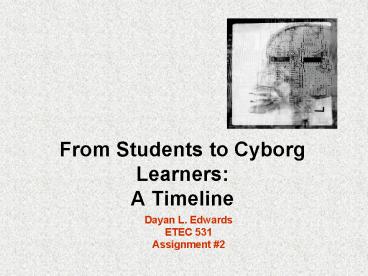From Students to Cyborg Learners: A Timeline PowerPoint PPT Presentation
1 / 17
Title: From Students to Cyborg Learners: A Timeline
1
From Students to Cyborg LearnersA Timeline
- Dayan L. Edwards
- ETEC 531
- Assignment 2
2
- The assumption that cognition occurs only within
the head of the learner has been challenged in
recent decades by experts interested in the
impact of technology on learning and cognition.
Milestones in this challenge and their
implication for education are summarized in
this presentation.
3
1960 The term cyborg is coined
by Clynes and Kline
Manfred Clynes and Nathan Kline use the term
cyborg (cybernetic organism) to refer to a
man-machine hybrid who could survive in outer
space.
4
1985 Donna Haraway applies the term
cyborg to all humans
- In her Cyborg Manifesto, Haraway argues that
being a cyborg is our ontology that is, our
way of being. She states that we are all
chimeras, theorized and fabricated hybrids of
machine and organism in short, we are cyborgs.
5
1991 Haraway reconceptualizes
knowledge
In Simians, Cyborgs, and Women The Reinvention
of Nature, Haraway redefines knowledge as
situated knowledges, claiming that
Accounts of a 'real' world do not, then, depend
on a logic of 'discovery,' but on a power-charged
social relation of 'conversation.' The world
neither speaks itself nor disappears in favor of
a master decoder. The codes of the world are not
still waiting only to be read. The world
encountered in knowledge projects is an active
entity.
6
In other words, according to Haraway, knowledge
is not solely constructed within the cyborgs
skull and skin but is co-constructed with other
humans, animals, and machines in the cyborgs
environment.
7
1995 Hutchins contends that
cognition is distributed
- Hutchinss theory of distributed cognition
proposes that cognition in the wild (in natural
settings) does not occur only in the head of the
solitary individual Instead, cognition is a
joint activity involving other agents both
human and machine.
8
- In contrast to entity-based theories, Hutchinss
theory of distributed cognition extends the
reach of what is considered cognitive beyond the
individual to encompass interactions between
people and with resources and materials in the
environment (Hollan, Hutchins, Kirsh, 2000).
9
1998 Salomon Almog describe how
technologies affect cognition
- Salomon Almog warn that a lack of
understanding of how technology impacts cognition
may have negative consequences for learners. As
an example, they point out that exposure to
poorly designed hypermedia may lead to shallow,
frail internalized cognitive networks a result
they refer to as the Butterfly Defect.
10
1999 Voithofer proclaims that students
and teachers are cyborgs
- In a presentation to the American Educational
Research Association, Voithofer argues that
cyborgs are not a phenomenon of the future but
that cyborgification of students and teachers
has, in fact, already occurred.
11
Voithofer concludes that educators must consider
forms of pedagogy that acknowledge the
characteristics of cyborgs that recognize that
cyborg learning represents a form of learning
that situates the student in a mediated
learning environment.
12
2000 Andy Clark describes the
extended mind
- Clark proposes that we are cyborgs not in the
merely superficial sense of combining flesh and
wires, but in the more profound sense of being
human-technology symbiots thinking and
reasoning systems whose minds and selves are
spread across biological brain and non-biological
circuitry.
13
- Clark notes that, if an external component of
the organism-environment system is removed, its
behavioral competence will decline just as it
would if part of the organisms brain were
removed.
14
In Press Stephen Petrina identifies
modes of learning with
technology
- Petrina states that many traditional learning
theories regard technologies as modes of
augmenting or amplifying the learning process.
He argues that this view masks the power that
technologies have to shape our actions, feelings,
and thoughts, and he identifies alternative
modes of learning with technology.
15
- One of the modes identified by Petrina is
cyborgenic learning. It is based on the premise
that, as cyborgs, we program and are programmed
in a learning process. In other words, learning
and cognition are products of organism-technology
interactions in which all elements play an active
role.
16
2004 Dayan Edwards answers the question
What are the implications of cyborgs
for education?
- Research and theorizing by philosophers,
anthropologists, educators, and others in the
past four decades imply that entity-based
theories of cognition are inadequate to explain
relationships between learners and technology.
The notion of a cyborg a hybrid of organism and
machine confirms that alternative theories are
needed. The theory of distributed cognition
appears to be well-suited to the
re-conceptualization of the student as a cyborg
learner.
17
References
- Clark, A. (2000). Natural born cyborgs? The Edge
Third Culture. Available at http//www.edge.org/3r
d_culture/clark/clark_p4.html. - Clynes, M. Kline, N. (1960). Cyborgs and space.
Astronautics, 14, 26-27 and 74-76. - Haraway, D. (1985). A manifesto for cyborgs
Science, technology, and socialist feminism in
the 1980s. Socialist Review, 15(2), 65-107. - Haraway, D. (1991). Simians, Cyborgs, and Women
The Reinvention of Nature. New York Routledge. - Hollan, J., Hutchins, E., Kirsh, D. (2000).
Distributed cognition Toward a new foundation
for human computer interaction research. ACM
Transactions on Computer-Human Interactions, 7,
174-196. - Hutchins, E. (1995). Cognition in the Wild.
Cambridge MIT Press. - Petrina, S. (in press). Curriculum and
Instruction for Technology Teachers. San
Francisco Jossey-Bass. - Salomon, G. Almog, T. (1998). Educational
psychology and technology A matter of reciprocal
relations. Teachers College Record, 100(1),
222-241. - Voithofer, R. J. (1999). Addressing the cyborg in
educational new media design. Presentation at
the American Educational Research Association
(AERA) National Conference, Montreal, Canada.

